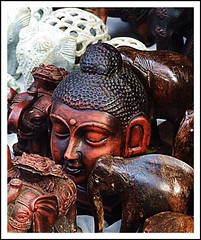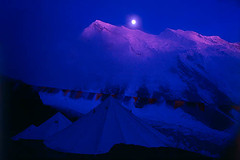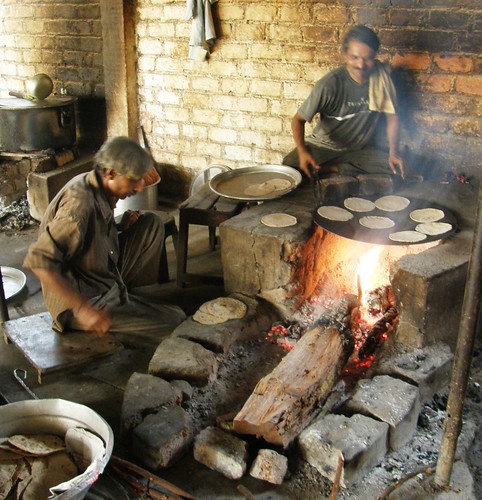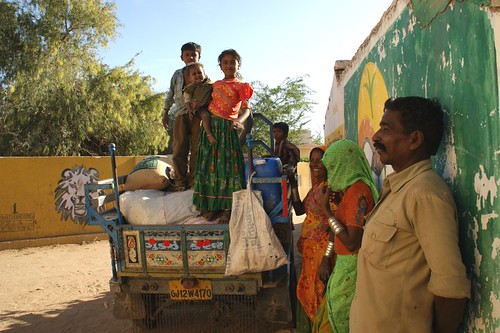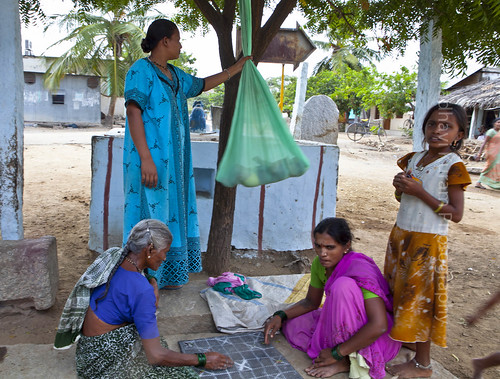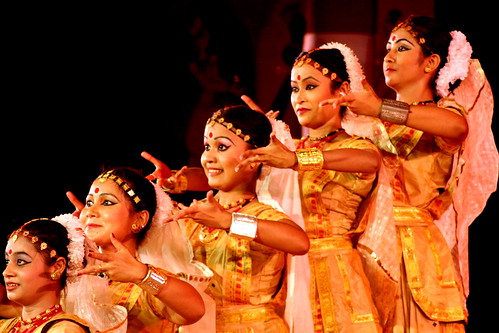Mass production of chapattis in an Ashram which rescues destitute, sick and disabled adults and children in Ujjain, India
The whole family as come to Khavda, in order to buy what is necessary to live rice, water, clothes....
How far we are from our occidental way of life !
A shot from Gujarat.
A calm stressless village life. While the grannies are playing the ludo the mother is swinging the baby in makeshit cradle. Quiet a way of spending siesta time in a village in Anegondi. A shot from Hampi, Karnataka.
The Sattriya dance has evolved out of performances that took shape in the vast network of sattras or monasteries that were established in Assam since the sixteenth century, when the Vaishnava movement led by Shankaradeva (1449-1568) swept the land. Dramatist and composer as much as social and religious reformer, Shankaradeva was the fountainhead of this great array of performance forms, and created a corpus of songs and dance-dramas that constitute the core of the edifice. It has subsequently been built up by the service of generations of artists at the sattras, whence a theatre art of the present day has emerged in recent times. The non-monastic Sattriya dance today is mainly the preserve of the laity.
The principal dances within the gamut of Sattriya are the Sutradhari Nach, the dance of the sutradhara or conductor; Krishna or Rama Nach, the dance of Lord Krishna or Rama; and Gopi Nach, the dance of the gopis or milkmaids of Vrindavana. Some of the other dances within the fold are Rasar Nach, based on the Rasa Lila of Krishna; Yuddhar Nach, a dance of combat using bows (dhanu) and arrows, or clubs (gada); Jhumara, a group dance performed with song but without abhinaya; and Chali Nach, a dance with stress on footwork. An artificial literary idiom, which has been called the Assamese Brajabuli, being a queer mixture of Assamese, Maithili, Hindi, and other elements, is used in Sattriya with intervening Sanskrit verses. The Sattriya dance possesses a number of hastas or hand movements (called hat), choreographic patterns, distinctive costumes, and a variety of masks. The music mostly depends on the khol, a drum associated with Vaishnava devotion in eastern India, and cymbals – pati tal, bhor tal – supporting ragas and other songs. There being no order of nuns in the sattras, there were no female dancers in Sattriya. Even in village performances, female roles were taken by boys. This has changed now, with professional female dancers dominating the stage.
Characters in the dances comprising Sattriya have their own special costumes. The sutradhara is generally dressed all in white: a turban (ready-made, of cloth, sometimes of paper today, and fitted often with silvery ribbon stripes), a long-sleeved jama or shirt, and a fluffy skirt (ghuri) tied on the waist with a waist-band with flower designs on it (tangali). For ornaments he puts on silver bangles (gamkharu) studded with stones, a lace with a drum-like golden bead in the middle (matamani), dangling ear-ornaments of gold (unti), and brass anklets (nepur). The gayan-bayan singers and accompanists are similarly, but more modestly, attired. Krishna, Rama and other male characters drape the legs with dhotis and combine this with colourful embroidered jackets. The gopis and other female characters use bright skirts and shawls. For make-up, colours prepared from vegetable dyes are used, and in most cases characters can be identified by the colours they wear.
Sattriya dance is being presented by the Sattriya Kendra, Guwahati, established as part of Sangeet Natak Akademi’s programme of support to Sattriya dance and associated with the sattras. Naren Chandra Baruah, and Ghana Kanta Bora Borbayan’s group will be performing Sattriya dance. Naren Chandra Baruah, who received his training in Sattriya dance and khol-playing under Paramananda Barbayan, has performed in various prestigious festivals. He is currently teaching Sattriya dance at Mitali Kala Kendra, Guwahati, and in a school for teaching Sattriya called Nrityabhumi which was founded by him. Ghana Kanta Bora Borbayan has been trained in the Sattriya dance and music traditions of Assam by several eminent gurus. He has also received training at the Kamalabari sattra of Majuli, Assam. A teacher of eminence, Ghana Kanta Bora Borbayan has been training students in Sattriya dance and allied disciplines for many years. He has been performing and attending seminars and symposia, introducing the Sattriya art in prestigious festivals in various parts of the country. Ghana Kanta Bora Borbayan has also received the Sangeet Natak Akademi Award, 2001 for his contribution to Sattriya dance.(Source Sangeet Natak Academy)




